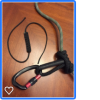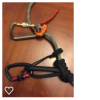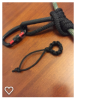3lilpigs
Member
- Joined
- May 24, 2021
- Messages
- 43
A few months ago when I started climbing, I was frustrated at how difficult it could be to slide the prusik knots on my linesman's belt and tether. I heard about using a Ropeman 1 in place of the prusik, because it was so much easier to adjust. I also heard the term "prusik tender" mentioned here and there, but didn't quite understand what they were for. So I dropped the $40-45 to get a Ropeman 1, and I loved it. It was pricey, but I could now adjust my linesman and tether with just one hand most of the time, and definitely more easily than before. But then I actually learned what a prusik tender was, and that it's just an extra little piece of equipment that does almost exactly the same thing but for $5 or less. I'd like to mention the pros and cons of both tools, and let you decide which (if either) you'd rather use. I'll also include instructions for the nearly free tender that I made. And any experts who see me omitting something or talking out of my ass, please feel free to chime in.
Ropeman 1- Essentially a small aluminum clip that attaches to your tether or linesman with a carabiner. A toothed cam allows the rope to easily tighten by pulling the tag end, but not play out. Lifting the cam allows you to put slack back in the rope. Pros: smaller than a prusik knot, arguably easier to manipulate than a prusik with tender, looks way cooler Cons: The first thing I'd better mention is a safety concern. As it wasn't designed for this climbing application, there's a potential that a fall could cause the mechanical teeth to damage and tear your rope, especially "degloving" the outer kernmantle (sheath) of your rope. Depending on your rope type and climbing style, this could have more or less potential to be dangerous. I decided that, for my rope type and climbing techniques, I wasn't worried about it. The Ropeman is also metal and can clank noisily against gear or trees. It's small, but it could be shiny enough to catch your prey's eye. Also, it costs $40-45 before shipping. That's not bad for a quality piece of climbing gear, but it feels like a lot when you realize that it's just for the convenience of using one hand rather than two.
Prusik tender-a device that might be as simple as a single amsteel loop, or as "complicated" as a plastic loop held in place by a light string or rope. It attaches to your carabiner at one end and slides on the rope behind the prusik knot. When I tighten a prusik without tender, my right hand pulls the slack end and my left pushes the prusik up the rope. The tender takes the place of my left hand. Pros: cheap and easy, no safety concerns beyond those of normal climbing. Cons: slightly more bulky than the Ropeman 1, takes just a liiiiittle more strength to pull tight.
On this side of things, I wish I'd learned about both tools before buying my Ropeman 1, and maybe even had a chance to try them both. I'm definitely going to continue to use my Ropeman. I love it. But the DIY tender I made from paracord took less than 5 minutes to make, and would have cost me maybe $1-2... if I didn't get my paracord for free. In conclusion, I think The Ropeman 1 is a fine luxury item (when used correctly) for people who have the cash to blow on it. I don't have cash to blow, so maybe I ought to start selling prusik tenders! Nah... in just a second I'll post directions for how you can make 'em out of paracord.

Ropeman 1- Essentially a small aluminum clip that attaches to your tether or linesman with a carabiner. A toothed cam allows the rope to easily tighten by pulling the tag end, but not play out. Lifting the cam allows you to put slack back in the rope. Pros: smaller than a prusik knot, arguably easier to manipulate than a prusik with tender, looks way cooler Cons: The first thing I'd better mention is a safety concern. As it wasn't designed for this climbing application, there's a potential that a fall could cause the mechanical teeth to damage and tear your rope, especially "degloving" the outer kernmantle (sheath) of your rope. Depending on your rope type and climbing style, this could have more or less potential to be dangerous. I decided that, for my rope type and climbing techniques, I wasn't worried about it. The Ropeman is also metal and can clank noisily against gear or trees. It's small, but it could be shiny enough to catch your prey's eye. Also, it costs $40-45 before shipping. That's not bad for a quality piece of climbing gear, but it feels like a lot when you realize that it's just for the convenience of using one hand rather than two.
Prusik tender-a device that might be as simple as a single amsteel loop, or as "complicated" as a plastic loop held in place by a light string or rope. It attaches to your carabiner at one end and slides on the rope behind the prusik knot. When I tighten a prusik without tender, my right hand pulls the slack end and my left pushes the prusik up the rope. The tender takes the place of my left hand. Pros: cheap and easy, no safety concerns beyond those of normal climbing. Cons: slightly more bulky than the Ropeman 1, takes just a liiiiittle more strength to pull tight.
On this side of things, I wish I'd learned about both tools before buying my Ropeman 1, and maybe even had a chance to try them both. I'm definitely going to continue to use my Ropeman. I love it. But the DIY tender I made from paracord took less than 5 minutes to make, and would have cost me maybe $1-2... if I didn't get my paracord for free. In conclusion, I think The Ropeman 1 is a fine luxury item (when used correctly) for people who have the cash to blow on it. I don't have cash to blow, so maybe I ought to start selling prusik tenders! Nah... in just a second I'll post directions for how you can make 'em out of paracord.


Last edited:




